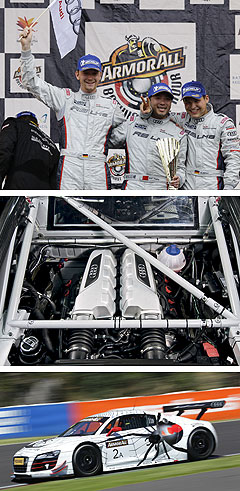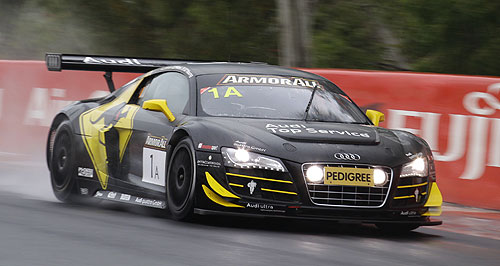Make / Model Search
News - AudiAudi production V10 races 20,000kmBlack Beauty: The Team Phoenix R8 continued Audi's domination of international long-distance racing by winning the Bathurst 12 Hour over the weekend. Five races and 130 hours on, winning Audi engine goes the distance at Bathurst27 Feb 2012 AN AUDI production-spec V10 engine crowned a staggering 20,000km of continuous racing in a Team Phoenix Racing R8 LMS GT3 sportscar when it won last weekend’s Bathurst 12 Hour – the car’s fifth international long-distance race on the trot without missing a beat. In what Audi says is a strong endorsement for its production technologies, the engine powered the car unchanged through the massively demanding 24-hour races at Spa and Nurburgring, as well as the hot 12 Hour of Sepang, in Malaysia, and another in Macau, before heading to Bathurst’s demanding Mount Panorama circuit. The engine will now be pensioned off after its latest win at the hands of international drivers Christopher Mies, Daryl O’Young and Christer Joens in the Bathurst race – Audi’s second in succession at the mountain. In a sport where it is not uncommon to change an engine after every race, the 5.2-litre engine in the German-based Phoenix Racing GT3 Audi sports car was merely checked on a dynamometer between races and then bolted back into the car, ready to go again.  Left: Christer Jöns, Christopher Mies and Darryl O’Young on the podium. Below: The engine and the second Team Phoenix car. Left: Christer Jöns, Christopher Mies and Darryl O’Young on the podium. Below: The engine and the second Team Phoenix car.All up, it covered 130 hours of track time, in testing, practice, qualifying and racing, with more than half of that time at full throttle. At Bathurst, it saw off challenges from Ferrari, Mercedes-Benz, Lamborghini and Porsche cars to finish ahead of a Mercedes-Benz SLS AMG and a Ferrari 458. Audi’s head of customer racing, Romolo Leibchen, who was one of seven Audi Motor Sport staffers to accompany independent Audi race teams to Bathurst for the event, said the engine was a standard production-line V10 except for a different driveshaft arrangement to suit the rear-drive racing format, removal of the anti-pollution plumbing on the air intake and addition of an air restrictor as required by the rules. He said the crankshaft and conrod bearings were the same as the units used in the road-going Audi R8 GT. Capable of 295km/h, the 419kW Audi LMS GT3 cars are prepared by Audi technicians for racing clients around the world, and all engines are expected to last the full racing season without major repair or rebuild before 20,000km. By contrast, V8 Supercar engines are rebuilt at 5000km. Mr Leibchen said the dual-clutch gearboxes – also standard production items – were less durable than the engines on the race track, having to be partly rebuilt every 5000km and then fully rebuilt at 10,000km, due to the hammering dished out by race drivers. Despite the reliability and durability of the race cars, Audi took no chances and brought 13 tonnes of spare parts to Bathurst for the event, including two spare engines and eight gearboxes – just in case. Audi’s other two works R8s, including the second Team Phoenix car driven by a trio including Australians Craig Lowndes, Warren Luff and Mark Eddy, failed to finish, not because of reliability problems but because of crashes in the wet conditions.  |
Click to shareAudi articlesResearch Audi Motor industry news |









Facebook Twitter Instagram